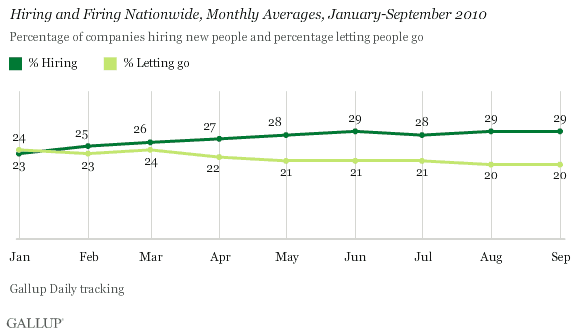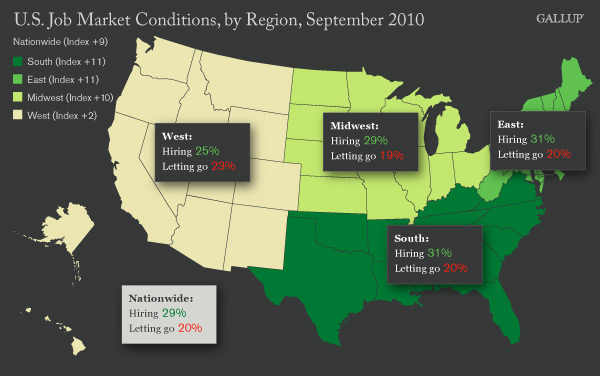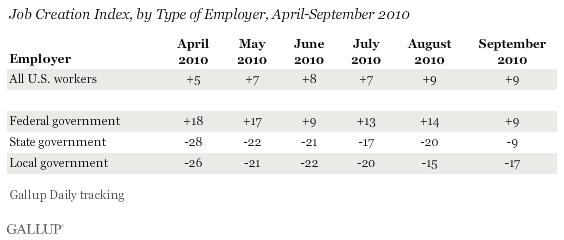PRINCETON, NJ -- Gallup's Job Creation Index remained at +9 in September -- meaning employee hiring and firing perceptions are unchanged from August, and essentially flat for the past five months. The percentage of working Americans who say their companies are hiring has been 28% or 29%, and the percentage saying their employers are letting workers go has been 20% or 21% since May.

Job market conditions are better now than they were at this time a year ago, when 24% of companies were hiring and 24% were letting employees go. They are still, however, far worse than in September 2008, as the first year of the recession was underway, when 35% of companies were hiring while 19% were letting workers go.
Job Market Perceptions Worsening in the West
In every region of the country, more employees continue to report that their companies are hiring than say their companies are letting employees go. This has been the case since May. However, it is getting to be a close call in the West, which continues to have the poorest job perceptions of any region, with 25% of employers hiring and 23% firing. This reflects a decline from August. Hiring and firing perceptions across the other three regions of the country are similar, with conditions improving slightly in the East and South, and unchanged in the Midwest.

Job Conditions at State and Local Governments Continue to Suffer; Federal, Not Suffering
Federal government employees report hiring and firing on par with the national average (+9). State (-9) and local (-17) government employees report less hiring and comparatively more employees being let go, although the state situation appears less negative than in recent months.

Commentary
The consensus forecast is that the government on Friday will report an increase in the U.S. unemployment rate to 9.7% in September from 9.6% in August. This would be consistent with Gallup's Job Creation Index that suggests job growth continues to trail the levels needed to keep up with normal workforce growth. Still, the size of the workforce continues to shrink as people leave it or do not join it. In turn, this decline in the workforce may moderate any immediate deterioration in the government's unemployment rate.
Right now, Wall Street and many economists tend to focus on private-sector job growth because the hiring and firing of temporary census takers have distorted the overall job numbers for many months. More importantly, private-sector jobs are essential if the U.S. economy is going to achieve a sustainable economic expansion. Still, Gallup's state and local government job data suggest that this area should not be ignored.
Regardless, Gallup's Daily underemployment measure continues to worsen. Thus, while Friday's unemployment report may have a significant impact on how the Federal Reserve deals with monetary policy going forward, the Fed may want to consider broader measures of the U.S. job situation as well.
Gallup.com reports results from these indexes in daily, weekly, and monthly averages and in Gallup.com stories. Complete trend data are always available to view and export in the following charts:
Daily: Employment, Economic Confidence and Job Creation, Consumer Spending
Weekly: Employment, Economic Confidence, Job Creation, Consumer Spending
Read more about Gallup's economic measures.
For Gallup Daily tracking, Gallup interviews approximately 1,000 national adults, aged 18 and older, each day. The Gallup Job Creation Index results are based on a random sample of approximately 500 current full- and part-time employees each day.
National results for September are based on Gallup Daily tracking interviews with 16,662 employees. For this sample, one can say with 95% confidence that the maximum margin of sampling error is ±1 percentage point. Regional results for August are based on interviews totaling more than 3,000 in each region. For each total regional sample, the maximum margin of sampling error is ±3 percentage points.
Interviews are conducted with respondents on landline telephones and cellular phones, with interviews conducted in Spanish for respondents who are primarily Spanish-speaking. Each daily sample includes a minimum quota of 150 cell phone respondents and 850 landline respondents, with additional minimum quotas among landline respondents for gender within region. Landline respondents are chosen at random within each household on the basis of which member had the most recent birthday.
Samples are weighted by gender, age, race, Hispanic ethnicity, education, region, adults in the household, cell phone-only status, cell phone-mostly status, and phone lines. Demographic weighting targets are based on the March 2009 Current Population Survey figures for the aged 18 and older non-institutionalized population living in U.S. telephone households. All reported margins of sampling error include the computed design effects for weighting and sample design.
In addition to sampling error, question wording and practical difficulties in conducting surveys can introduce error or bias into the findings of public opinion polls.
For more details on Gallup's polling methodology, visit https://www.gallup.com/.
